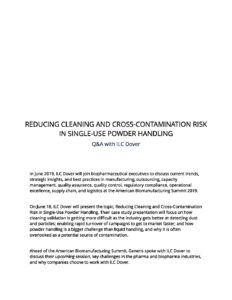In June 2019, ILC Dover will join biopharmaceutical executives to discuss current trends, strategic insights, and best practices in manufacturing, outsourcing, capacity management, quality assurance, quality control, regulatory compliance, operational excellence, supply chain, and logistics at the American Biomanufacturing Summit 2019.
On June 2018, ILC Dover will present the topics, “Reducing Cleaning and Cross-Contamination Risk in Single-Use Powder Handling”. Their case study presentation will focus on how cleaning validation is getting more difficult as the industry gets better at detecting dust and particles; enabling rapid turnover of campaigns to get to market faster; and how powder handling is a bigger challenge than liquid handling, and why it is often overlooked as a potential source of contamination.
Ahead of the American Biomanufacturing Summit, Generis spoke with ILC Dover to discuss their upcoming session, key challenges in the pharma and biopharma industries, and why companies choose to work with ILC Dover.
This is an excerpt from the Q&A we did with ILC Dover:
“What evolving containment needs are the pharmaceutical and biopharmaceutical industries currently facing?
The top industry trends can be described by the product or therapy that is being handled. The antibody drug conjugate (ADC) market is growing at an estimated 20% CAGR, and a key issue is safety when handling the product and protection of the product from contamination. The payload component of the ADC requires containment at or below 30.0 nanograms/m3. The isolator designs need to be robust with a clear risk analysis to assure these risks have been mitigated. Once the payload is conjugated with the biologic (Mab’s), the ADC must be handled in a sterile environment and so containment for operator and environmental protection is still needed along with processing steps in an aseptic environment.
Another therapy area that is growing rapidly is Cell and Gene Therapy, where donor materials are handled in vivo. This makes the isolation and containment extremely critical to not contaminate the donor cells with particulate or with the cell modification processes like viral vectors.”
Click through to read the full Q&A here.

